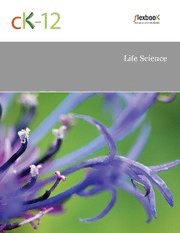
Life Science PDF
Preview Life Science
Life Science CK-12Foundationisanon-profitorganizationwithamissiontoreducethecostoftextbook materialsfortheK-12marketbothintheU.S.andworldwide.Usinganopen-content, web-basedcollaborativemodeltermedthe"FlexBook,"CK-12intendstopioneerthe generationanddistributionofhighqualityeducationalcontentthatwillservebothas coretextaswellasprovideanadaptiveenvironmentforlearning. www.ck12.org CK-12usersshouldtreatthisFlexBookasanonlinetextbook.ThisFlexBookunderwent athoroughreviewconductedbypracticingteachers,domainexperts,copyeditors,and technicaleditors.Itcanbeusedinitscurrentform,"flexed"(customized),and/orprinted bytheuser.CK-12supportsfeedbackonallofitsFlexBookssothattheycanbecontinually improvedandupdated,whileremainingalignedwithstatestandardsandcurriculum guidelines. ThisFlexBookcontainsreferencestoadditionalresourcesandlinkstoexternalwebsites thatareprovidedbythecontributingauthorsassupplementalmaterials.CK-12Foundation neitherendorsesthesereferencesnorisresponsiblefortheircontentoravailability.Also, theinclusionofanyreferencetoanexternalresourceorlinktoawebsitedoesnotimply endorsementbyCK-12Foundationoftheirowners,productsorservices. ThismaterialislicensedundertheCreativeCommonsAttribution-ShareAlikelicense (http://creativecommons.org/licenses/by-sa/3.0/). Printdate:2009-06-1208:19 CK12psn:08aebdc6f417d7371eb07c346396f42c ii Authors Jean Brainard, Niamh Gray-Wilson, Jessica Harwood, Corliss Karasov, Doris Kraus, and Jane Willan. Supported by CK-12 Foundation iii iv Contents 1. StudyingLife..................................................................................................................................... 1 2. IntroductiontoLivingOrganisms................................................................................................. 31 3. CellsandTheirStructures............................................................................................................. 55 4. CellFunctions................................................................................................................................. 69 5. Cell Division,Reproduction,and DNA......................................................................................... 89 6. Genetics........................................................................................................................................ 111 7. Evolution....................................................................................................................................... 133 8. Prokaryotes................................................................................................................................... 173 9. ProtistsandFungi........................................................................................................................ 189 10. Plants............................................................................................................................................. 207 11. Introduction to Invertebrates...................................................................................................... 239 12. Other Invertebrates...................................................................................................................... 257 13. Fishes,Amphibians,andReptiles.............................................................................................. 293 14. Birds and Mammals..................................................................................................................... 325 15. BehaviorofAnimals..................................................................................................................... 353 16. Skin, Bones, and Muscles........................................................................................................... 381 17. FoodandtheDigestiveSystem.................................................................................................. 417 18. CardiovascularSystem................................................................................................................ 447 19. Respiratory and Excretory Systems.......................................................................................... 481 20. ControllingtheBody.................................................................................................................... 505 21. DiseasesandtheBody'sDefenses............................................................................................ 545 22. ReproductiveSystemsandLifeStages..................................................................................... 575 23. From Populations to the Biosphere........................................................................................... 607 24. Ecosystem Dynamics.................................................................................................................. 643 25. Environmental Problems............................................................................................................. 663 v vi 1. Studying Life The Nature of Science LessonObjectives • Understandthatscienceisasystembasedonevidence,testing,andreasoning. • Describewhatthelifesciencesareandsomeofthemanylifesciencespecialties. • Describethescientificmethodandwhyitisimportant. • Definethewords"fact,""theory,"and"hypothesis." • Describesomeofthetoolsoflifescience. • Knowthatscientistsarerequiredtofollowstrictguidelines. CheckYourUnderstanding • Whatdoyouexpecttolearnfromthisclass? Introduction • Knowthatscienceisawayofknowingaboutthephysicalworld,basedonobservableevidence,testing, predictions,andreasoning. • Inscience,theoriesandknowledgeareconstantlytestedandquestioned.Whennewinformationconflicts withexistingexplanations,scientistsmodifytheirexplanationstobeconsistentwithallevidence. • Understand that principles of philosophy and religion usually cannot be tested scientifically, because theyarenotbasedonobservableevidence. • Identify what the life sciences are and some of the many specialties and know the difference between scientifictheoryandfact.Whyismodernscienceproducingmanymoreimprovementsinourlivesthan itdidahundredyearsago?Isthereanythingthatsciencecannotexplain?Howcanwe“thinklikescien- tists?” • Know how to ask questions about the world around you and how to answer those questions based on yourunderstandingofevidence,testingandreasoning. • Continuallyquestionandtesttheaccuracyofyourknowledgeandassumptions. GoalsofScience Science,religion,mythology,andmagicsharethegoalofknowingaboutandexplainingtheworld,suchas thephysicalworld,buttheirapproachesarevastlydifferent.Thedifferencebetweenthemistheirapproach to “knowing.” The vastness of the living, physical world includes all organisms. As humans, some of the thingswewanttoknowandunderstandarewhatmakesushealthy,whatmakesussick,andhowwecan protectourselvesfromfloods,famineanddrought. 1 Figure1:Escherichiacolibacteria. (Source:http://en.wikipedia.org/wiki/Image:EscherichiaColi_NIAID.jpg,License:PublicDomain) Figure2:Amalelion. (Source:http://en.wikipedia.org/wiki/Image:Lion_waiting_in_Nambia.jpg,License:CreativeCommons Attribution2.0) Figure3:AHumpbackwhale. (Source:http://en.wikipedia.org/wiki/Image:Humpback_stellwagen_edit.jpg,License:GNUFree Documentation) 2 Throughout history, humans have looked for ways to understand and explain the physical world. Try to imaginewhathumansthoughtaboutthemselvesandtheworldaroundthem1,000yearsago,or5,000years ago, or more. If you were born then, how would you have explained why the sun moved across the sky, thendisappeared?Howwouldyouexplainwhyyourbodychangesasyougrow,orbirthanddeath?What explanationwouldyouhaveforlightening,thunder,andstorms? Figure4:TheanatomylessonofDr.NicolaesTulp. (Source:http://en.wikipedia.org/wiki/Image:The_Anatomy_Lesson.jpg,License:PublicDomain) Figure5:In1847,adoctor,IgnazSemmelweis,demonstratedthatwhenhewashedhishandbeforedeliv- eringbabiesfewerwomendiedfrominfection.Beforethis,doctorshelduntestedbeliefsaboutthecauses ofdisease,suchasaperson’sbehavior,ortheairtheybreathed. (Source:Wikipedia,Artist:RobertA.Thom,License:PublicDomain) Throughouttime,differentcultureshavecreatedhundredsofdifferentmythsandstoriesandevengodsto explain what they saw. Ancient Greeks explained that lightening was a show of their god Zeus’ anger. Scandinaviansclaimedthattheirgodofthunder,Thor,wasresponsiblefortherumblingandboltsoflightning. Withoutanyformalscience,manycultureshavealsoblameddiseases,suchasepilepsy,onevilspiritsand otherimaginaryentities.Forexample,thereisevidencethatmanydifferentculturesdrilledholesintheskulls 3 ofpatientswhohadseizuresorothermaladies,thinkingthattheywerereleasingevilspirits. ScienceasaWayofKnowing Duringyoursandyourparents’lifetimes,advancesinmedicine,technology,andotherfieldshaveprogressed fasterthananyothertimeinhistory.Thisexplosionofadvancesinourlivesislargelyduetohumanuseof modern science as a way of understanding. Today’s scientists are trained to base their comprehension of theworldonevidenceandreasoningratherthanbeliefandassumptions. Modernscienceis: • Awayofunderstandingaboutthephysicalworld,basedonobservableevidence,reasoning,andrepeated testing. • Abodyofknowledgethatisbasedonobservableevidence,experimentation,reasoning,andrepeated testing. Aswelearnmore,newinformationoccasionallyconflictswithourcurrentunderstanding.Whenthishappens scientific explanations are revised. However, science cannot scrutinize what is good versus what is bad (morality),becausethesearevalues,ideasthatlackmeasurableevidence.Scienceisnotusedtoexamine philosophyorsupernaturalentities,suchastheexistenceornonexistenceofagod.However,sciencecan beusedtoexaminetheeffectsoftheseexperiences. Themostimportantmessagefromthischapteristhatscienceisnotonlyawayofknowingitisalsoaway ofthinkingandreasoning.Scientiststrytolookattheworldobjectively-withoutbiasormakingassumptions. How? Scientists learn to be skeptical, to question the accuracy our ideas. They learn to base their under- standingofthephysicalworldonevidence,reasoningandrepeatedtestingofideas. ToThinkLikeaScientist Tothinklikeascientist,youneedtobeskepticalaboutandquestionyourassumptions,includingwhatoften seemslikecommonsense.Questioningideascanoftenleadtosurprisingresults.Forexample,ifyouask people whether it's easier to keep a plastic cutting board clean or a wooden one clean, most people will thinkthattheplasticboardiseasiertokeepcleanandhasfewergerms. Figure6:Whichissafer,aplasticorwoodcuttingboard? Why do most people believe that plastic is safer? Probably because we assume that it is easier to wash germsoffplasticthanoffwood.Thisassumptionispromotedbythemakersofplasticcuttingboardsandit sounds reasonable. After all, wood stains and looks unhygienic; plastic cutting boards come out of the dishwashershinyandcleanlooking.Butisplasticactuallybetter? Whenscientiststestedthisidea,theanswerturnedouttobeno.Theresearcherstreatedusedcuttingboards withdifferentkindsofgermsandthenwashedtheboards.Theyfound,muchtotheirsurprise,thatgouged 4
